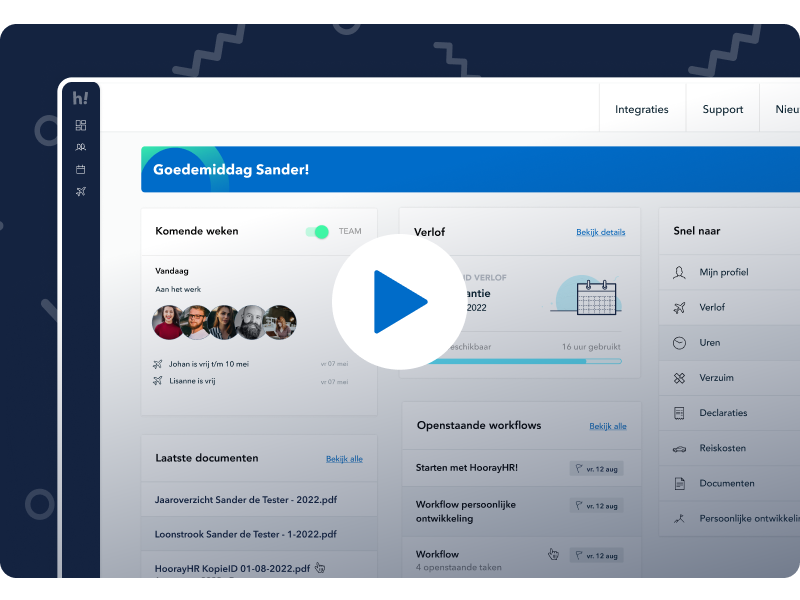
All leave categories outlined
All leave categories outlined: A complete overview
Please note: These categories apply to the Netherlands only.
Keeping an overview of all the types of leave isn’t easy because we’ve got quite a lot of them.
Next to taking leave for holidays, employees are entitled to other types of leave as well. The good news is that you can register all types of leave in HoorayHR easily. And even better: you can create reports with the different types outlined in them.
An overview of all types of leave:
Care leave
Care leave is meant for employees who have someone close to them in need of care due to illness. When a child, partner, or parent of the employee is ill, the employee can take short-term care leave. If one of them has a life-treathening illness for a longer period of time, the employee has the right to take long-term care leave.
– The precondition for getting short-term or long-term care leave is that your employee is the only one able to take care of the ill relative. So, if a partner or parent is in the hospital, you cannot apply for care leave because the relative is taken care of in the hospital.
– You can only take care leave for direct family. Direct family includes children, partners, parents, grandparents, grandchildren, and siblings. Aside from direct family, you can also take care leave for someone who is living with you, such as an aunt or a friend. However, the relationship should be such that your employee is the only one who is able to take care of this person.
– The employer is not allowed to refuse a care leave application, except when the company will be in serious trouble because of it.
Short-term care leave
Short-term care leave is a maximum of 2 times the number of hours your employee works per week. This applies for a period of 12 months. Employees may take short-term care leave more than once every 12 months. But the maximum number of hours may not be exceeded. The 12-month period begins on the 1st day of the leave.
Long-term care leave
Employees are entitled to a maximum of 6 times the number of hours they work per week in any 12-month period. Employees take long-term care leave in a consecutive period of up to 12 weeks. The maximum number of hours of leave per week is half of the working hours per week.
Want to know more about care leave, such as how it should be requested and the rights of the employer? Read the government website (page only available in Dutch) for more information.
Emergency leave
This type of leave is used in case the employee needs to leave right away due to exceptional and unforseen circumstances. Emergency leave is for this purpose: they need to take immediate time off due to circumstances in their personal life.
The following cases make you entitled for emergency leave:
- if the employee must take time off immediately due to a situation of force majeure;
- if the employee can only fulfil a legal or governmental obligation when given time off;
- if the employee must take time off due to special personal circumstances.
Examples of circumstances in which you have the right to take emergency leave:
- the child of an employee is suddenly ill and has to be picked up from school;
- your employee needs to see the doctor and that’s only possible during working hours;
- the partner of the employee needs to give birth;
- the water pipe of the employee has burst.
The wage continues to be paid during emergency leave, unless otherwise stated in the CLA.
Want to know all about emergency leave? Check the government website (page only available in Dutch).
Pregnancy leave and maternity leave
Employees who are pregnant are of course entitled to take pregnancy leave. Employees with a baby on the way are entitled to 6 weeks of pregnancy leave and at least 10 weeks of maternity leave. This is a total of 16 weeks. The maternity leave can be taken in stages.
There are special rules for calculating when to take pregnancy leave and maternity leave. This depends on the date when the child is born, for example. Read all rules regarding pregnancy leave and maternity leave on the government website.
Partner/paternity leave
If your employee is a spouse or partner of the mother with a newborn baby then the employee is entitled to 1 week of partner leave. The employer will continue to pay wages during this period.
Extended partner leave
In addition to partner leave, employees have the option of taking up to 5 weeks of additional partner leave. You may take the additional partner leave at intervals of but within 6 months after the birth of the child. The employee does not receive leave for this period, but a benefit from the UWV. This benefit is a maximum of 70% of the daily wage.
Want to know everything about partner leave and extended partner leave? For example, about the accumulation of holidays and pension during this leave? Read all the rules about partner leave and extended partner leave (page available only in Dutch) on the website of the Dutch government.
Parental leave
Employees with children up to the age of 8 may take parental leave so that they temporarily work less. Employees are entitled to up to 26 times the number of work hours per week. Your employee is entitled to parental leave for each child. Parental leave also applies to foster children, stepchildren and prospective adopted children.
There are several rules associated with applying for parental leave. Read all the rules about parental leave here (page only available in Dutch).
Adoption leave and foster leave
To ensure that parents and child can get used to each other, there is adoption leave or foster leave. From two weeks before the child comes into your home, the adoption or foster care leave may start. Both parents may take a minimum of 6 weeks adoption leave or foster care leave spread over 26 weeks.
Read all about adoption leave and foster leave (page only available in Dutch).
Special or extraordinary leave
No legal rules have been established around a number of types of leave. These types of leave are referred to as extraordinary leave or special leave. For example, an exam, a marriage and a visit to the dentist.
Your CLA, employment contract or the leave regulations of your organisation state which matters apply to special or extraordinary leave.
Read all about extraordinary leave (page only available in Dutch).
Unpaid leave
For some of the above types of leave, you may not get paid so you will take unpaid leave. In addition, it is possible at many organisations to take unpaid leave, for example for a world trip. The exact rules surrounding unpaid leave can be found in your employment contract, CLA or in the employee handbook.
Do you want to know what the consequences of unpaid leave are, for example for accruing holidays? Then check the website of the Dutch government about unpaid leave.
Discover the possibilities with HoorayHR





